(Re)Envisioning the Orchestra: An Interview with Eric Jacobsen, Conductor and Founding Cellist of The Knights
Q: Could you please begin by telling me about your musical background? Did you have any particularly strong musical influences or mentors as a young cellist?
I was very fortunate to have two musical parents – my father was a violinist with the Metropolitan Opera and my mother was a flutist. My parents’ friends would come over and read chamber music every couple of months, so music-making was an informal and familiar part of life. It was also influential looking up to my older brother Colin, who is a great violinist.
I had three great teachers before college. Laura Epstein and Ardyth Alton gave me a love and respect for the instrument. When I was 14 I began studying with Joe Elworthy. The steps that he taught me for careful study and practice more-or-less made it possible for me to become a cellist. Then, my teacher at Juilliard, Harvey Shapiro, taught me almost every day for four years (yes, that’s easily over 1000 lessons)! I was lucky to have a very special bond with Mr. Shapiro. Two major influences in the past few years, though I don’t play for them often, are Anner Bylsma and Yo-Yo Ma. I learn so much working with Yo-Yo in just an hour’s time sitting on stage next to him in the Silk Road Ensemble. Anner inspires questioning and hope and just plays the hell out of the cello!
Q: What was the inspiration for the formation of The Knights? When and how did it come about as a formal ensemble?
The first time the name “The Knights” was ever used, I was a junior in high school. I was performing Haydn’s D major Cello Concerto and wanted a group of friends to perform with me. Around that time, almost every Saturday, my brother and I would invite friends over to our house and we would read chamber music for hours. About 35 people would come regularly just to play music. So when I was preparing for this recital and needed a name for the ensemble, I came up with “The Knights of the Many-Sided Table,” inspired by some King Arthur book I was reading. It was a joke – there was no real idea behind it at the time.
A couple years after that, my brother and I did another chamber orchestra concert that we really rehearsed for, and a lot of the same people were involved. Our distinct rehearsal process started to take shape and therefore the sound of the orchestra began to emerge. The history of friends reading chamber music as a pastime and the history of these musicians forming an orchestra were synonymous. About five years ago we decided this was something we really wanted to continue – it brought us a revitalized energy, which we sought to convey to the audience through our commitment to the music. The group began to champion music, to rehearse as much as possible in order to give the music what it deserves. The group was beginning to stand for a quest of sorts, always searching out, seeking to bring new in and put new out. So the name – now simply “The Knights” – really means something bold and true to the cause.
Q: The ensemble has grown from a group of friends reading chamber music into a critically-acclaimed orchestra recognized by the media, the public, and the classical music establishment both here and abroad. What or who helped facilitate this? Did you have any particularly important mentors or supporters along the way?
The answer has to do with specific people in the group. It’s an incredible collection of individuals who are so committed to what they do and who come from a variety of musical backgrounds. We have a violinist, Christina Courtin, who is also a singer- songwriter with Nonesuch Records. She brings an unbelievable knowledge of all kinds of music, as well as knowledge of the creation of music, which gives us an eye into the composer’s mind.
We rehearse a lot. It’s great to have the time to try out many people’s ideas – I believe this brings power and interest to the group. It enables us to trust each other and to be free in performance. People see the collaborative spirit in which we work. Whether that brings us international acclaim or not, we are doing something we believe in.
We are now working with Opus 3 Artists. Mary Pat Buekle, our manager, is a hero and a mentor – someone we can look up to and ask questions about the business. She is a Knight in her own right and has also joined in the cause. There have been many “angels” along the way who have helped us, both financially and with advice and insight into what we could and should be doing. These people are all Knights! If they were musicians, they would be playing with us. It’s key to find the people who have common goals, whether they play in the orchestra or are members of our board.
Q: How do you determine ensemble members?
There are no formal auditions and we don’t foresee having them. We usually find players by word of mouth so most of the people who join are friends or colleagues of one or two degrees of separation. We often like reading chamber music and talking with new players. That’s the way we have found people who are suitable for the group and have a vested interest in it. We’ve been fortunate to encounter people who have liked the group and wanted to be a part of it. It’s been similar finding board members and directors.
Q: As I understand, you conduct some concerts, and other concerts are performed Orpheus-style, without conductor. How do you decide which concerts will be conducted and which will not?
The one litmus test for whether or not I conduct is to determine what will better serve the music. When we play a Beethoven Symphony, we could without question sit down and read it without a conductor, but we feel the best and quickest way to jump to the next level is to have one. In The Knights, one member might suggest something, and then another player suggests something else. We need someone to gather these ideas, put them together and try them out, and the best way we’ve found to do this is to have a conductor. To quote my brother Colin, a conductor is a “catalyst for mutual understanding” rather than a dictator.
When I conduct, I consider myself an “extremely biased mediator.” I feel obligated to be so incredibly prepared that no one would question why I am taking on this role. (My musical opinions, like everyone’s in the group, can be discussed, but my preparation and physical understanding of conducting needs to be sound). When I come into rehearsals to conduct, I am biased, I have strong musical opinions. Someone else might have an idea that is chosen for a particular section or specific concert, but that idea becomes what I want – if there is a group of people who want something to be another way, I accept it, embrace it, and it becomes my opinion. In a leadership role, one must do what is better for the group. It’s a collaboration, which means there is negotiation and cooperation involved.
Q: How do you balance the programming of repertoire to reflect both the uniqueness of the ensemble and your respect for the time-honored tradition of classical music? Do you find this balance appeals to audiences of a variety of ages and backgrounds?
When we program repertoire, we want to put music together in a way that makes sense to us. Playing an overture, a concerto, and a symphony can no doubt be a beautiful program. But we often want to find something with a specific link. As an example, a concert we are giving in Central Park this summer is dedicated to Schubert and Minimalism. This will also be recorded for Ancalagon Records. The link between Schubert and minimalist composers like Glass and Feldman is quite evident to us and we think the music will be insightful together.
The program is as follows:
Satie – Gymnopedie (arr Debussy)
Schubert – ‘Unfinished’ Symphony
Glass – ‘Company’
Schubert – Symphony No 3
Feldman – ‘Maddam Press Dies at 90’
Satie – Gymnopedie (arr Debussy)
This kind of programming helps us communicate with the audience. I remember an interview with a famous conductor who was asked if the audience had any impact on the performance, and he said no, that the orchestra would play exactly the same and he would conduct exactly the same without the audience there. Of course, no one in the audience is putting their 3rd finger down for the cellist but to think that audience members are purely onlookers behind a 2-way mirror is preposterous! There are times we find ourselves doing programs that are different in some way, such as programming standard repertoire with something out of the ordinary. It’s not to attract our sponsor base, because our sponsor base comes to our concerts anyways. We play Beethoven because we love it. You can never please everyone in the audience. It’s a luxury that we don’t have to fill a 3000-seat concert hall three times a week. When music is done the right way with commitment and enthusiasm, it reaches people. Programming music that people might see as ‘out’ or ‘uninteresting’ or ‘too modern’ has a lot to do with context. I cook a lot and I love food so I make a lot of edible references. Vanilla is one of the key ingredients to many great dishes. Without context it smells good but tastes harsh and aggressive on the mouth, but mix it with eggs, cream, a bit of sugar, cinnamon, brandy and challah bread and you some of the best French toast out there.
Q: What are some of the challenges you’ve faced in maintaining the orchestra?
On a musical level, one of our challenges is also one of our greatest strengths. The way we work is very communal – absolutely everyone in the group is encouraged to participate in the rehearsal process. This means that 40 people, all trained and well-versed in many styles of music, contribute to the rehearsal and decision-making process. This is a challenge, but one that leads to great success and growth. It’s a question of how to take many ideas and meld them into one. I think of the group in terms of e pluribus unum – everyone for one. You put in your two cents, ten cents, or ten dollars, step back and see what emerges, both personally and for the collective.
Q: What is your vision for the future of the Knights?
We have an ideal model for what can work – a sort of 5-year plan. After that, who knows where the group will actually venture. One of the best ways we feel we can sustain the high energy and number of rehearsals is to operate during three time periods per year – early fall, winter, and spring – with the goal being to build upon the culture that has emerged in the group and to be able to continue growing. We’d love to continue with “retreats” – leaving the city and rehearsing away from all the other requirements life holds. We don’t want to be a full-time orchestra at this point. We have members of four different string quartets, soloists, singers, and teachers in the orchestra, and all of these things have to go on simultaneously. It’s also our goal to be the go-to orchestra for super-cool projects. Musically speaking, we’re doing what we want – we’re growing together. Every time we come together again we’re more spontaneous in our playing and understanding. We’re very interested in education as well. We want people to experience our ensemble as a possible model of how groups can communicate and operate. Ideally this approach could transfer to how people communicate between different cultures.
Q: To what extent do you feel it is necessary for musicians to be engaged in their communities?
It’s interesting that you choose the word “necessary.” Everyone has their own way of communicating – many people do their jobs remarkably well yet they don’t necessarily want to be part of a greater community. I feel, however, that as musicians today, we are ambassadors of our art and of education. It is said that music is another language, but what if we went one step further and said that it’s the ultimate language? In any language there is probably a phrase like, “it’s so ____ I can’t express it in words.” So how can you express it? Music. It becomes not only a link because we all like it, but because it’s an absolute connective tissue in the world. Because we have that power to express and communicate where words cannot, I do think it’s necessary to grow with a community – it’s more-or-less imperative in today’s world.
Q: What do you believe to be the importance of creating one’s own opportunities and “carving a space” for oneself in the contemporary classical music world?
As younger musicians trying to find a place to exist in the musical world, it’s paramount to be able to see what you want and go and get it. There’s something about wanting to see something all the way through that keeps me moving. I also think it’s necessary for the growth of the industry itself. Something in the classical music establishment is obviously not connecting, and we don’t want to sit there with everyone else worrying about funding and the future. No one quite has the answer, but there are changes happening today. When we talk about a group like the Knights, which is carving out a place for itself, I like the idea that it is not displacing anyone. The respect I have for the great orchestras of the world is enormous – the way they continue to find the energy, finance, and commitment to play this great music is amazing. In no world does the New York Philharmonic not exist where The Knights exists – it’s beautiful that they exist together, next to one another, and they both have their place. I hope they might even help each other.
Q: How do you manage to juggle such a diverse and active musical career?
I have no idea! Sometimes I do things that are just ridiculous. Three months in advance I’ll set up a rehearsal from 10:00 to 2:00 on a Sunday, a 2:30 concert, and a 6:00 rehearsal for an 8:00 show somewhere else, initially thinking it’s fine – then in the midst of it, I realize I was being absolutely crazy! As I get older, I realize more and more what’s physically possible. Our manager for The Knights and Brooklyn Rider, Mary Pat Buekle, has helped us understand what is reasonable and what is not. For me, being able to wear multiple hats as an organizer, cellist, and conductor requires that each is given its due time.
Q: Could you please share any thoughts you might have for young professional musicians and conservatory students as they embark on their musical careers?
We all say that we’ve worked hard and that we’ve been helped a lot along the way through the guidance of teachers, family, friends, and colleagues. It’s important to always keep that in mind. Also, every opportunity to perform in front of people is a major opportunity and should be taken seriously, and should have meaning. It’s important not only to have an eye towards the immediate past but also an eye much further back, looking towards styles that are different now. With recorded music, we have a history of over 100 years. The general idea is to start at the source, or as close to the source as possible. It is something that motivates us all to try new things – not just to stay in the place where we’re comfortable.
Eric Jacobsen bio:
Eric Jacobsen is a cellist and conductor residing in Brooklyn, New York. He has performed with Renée Fleming and Bono, and is a member of Yo-Yo Ma’s Silk Road Ensemble and Mark O’Connor’s string quartet. Mr. Jacobsen is also the cellist of acclaimed string quartet Brooklyn Rider, formed with his brother Colin Jacobsen, Johnny Gandelsman and Nick Cords in 2006. Eric and Colin Jacobsen are the Artistic Directors of The Knights, a chamber orchestra that Eric conducts. As conductor, Mr. Jacobsen has led The Knights at the opening of the Dresden Musikfestspiele with soloists Dawn Upshaw and Christina Courtin, and will conduct The Knights at The Caramoor Festival with Yo-Yo Ma as soloist in September 2010. Mr. Jacobsen was recently appointed to the cello and chamber music faculty at New York University, where he has also conducted the orchestra. A graduate of The Juilliard School, Mr. Jacobsen studied with the late Harvey Shapiro. He also worked extensively with Joseph Elworthy, and considers Anner Bylsma and Yo-Yo Ma instrumental influences in his playing. Mr. Jacobsen has been a fellow at the American Academy of Conducting in Aspen with David Zinman.”

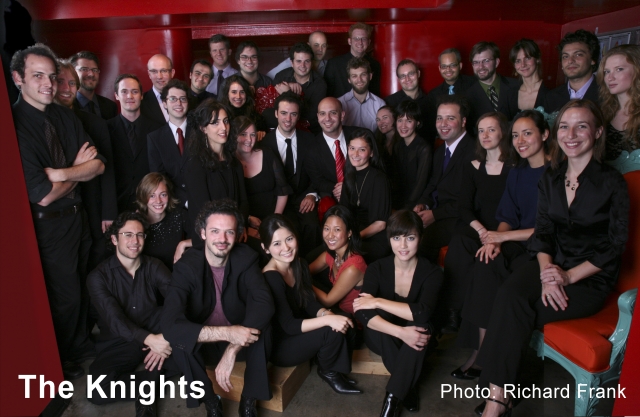
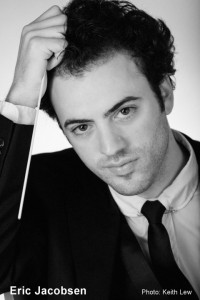
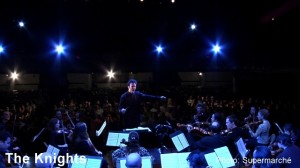
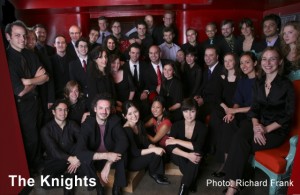
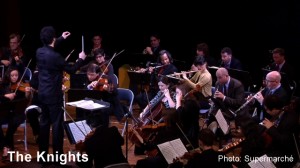
No comments yet.
Add your comment